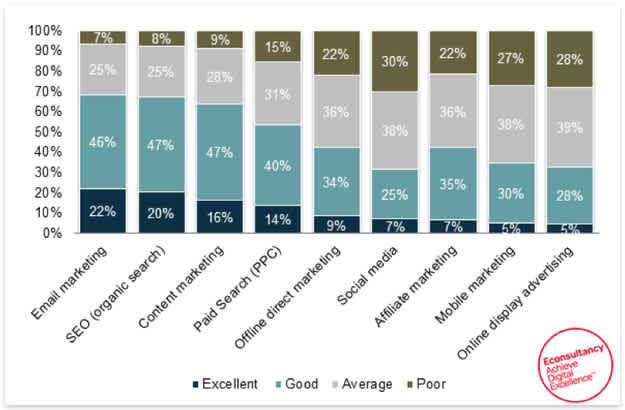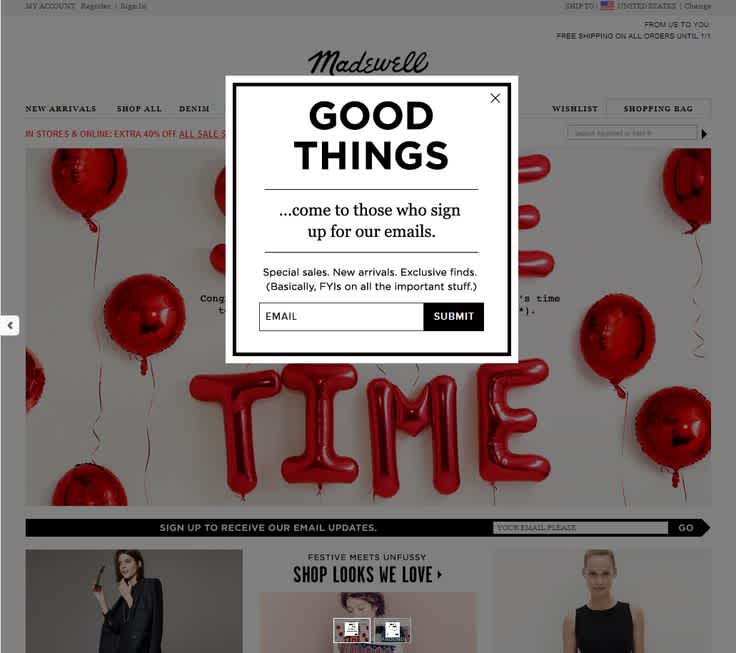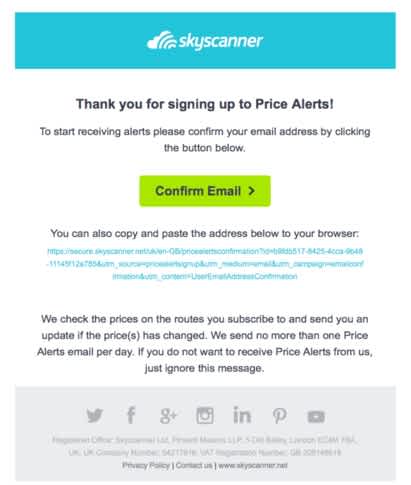When you’re just starting out with email marketing, it can seem like there’s a never-ending checklist of to-dos. Building your contact list, planning your email marketing strategy and learning from your results… There’s just too much to think about.
Don’t fret though, we’re here to get you started without breaking a sweat. This guide’s going to cover the ins-and-outs, the A to Z of all the essentials. Ready to kick-start your email marketing strategy? Read on!
Chapter 01
What is email marketing?
Email marketing is one segment of a company’s overall digital marketing strategy.
Email marketing is the use of email to promote products or services and to develop a relationship with a database of existing and potential customers, that helps us achieve our marketing goals.
Chapter 02
Why email marketing?
Email marketing is still the best performing marketing channel, outperforming others like social media, search engine optimization, paid search and affiliate marketing. In fact, according the the DMA, email marketing’s return on investment (ROI) is up to £32.28 for every £1 spent, from £30.03 the previous year.
The main reason is that email marketing is the only channel that allows companies to target their audience with personalized messages, which not only enables them to promote their products/services, but also to build and nurture relationships with clients at different stages of the customer lifecycle.

Source: Econsultancy, 2016
Chapter 03
How to do email marketing right
We’ve told you how effective email marketing is, and probably by now you’re already eager to get started. Worry not, we’re here to tell you what you need to do.
Build your email marketing contact list
Step one when planning your email marketing strategy is actually having people to send your emails to. There are many ways to grow your customer base organically: using your different channels, providing incentives, relying on word-of-mouth… Overall, emailing is all about testing different things. One method might work more quickly for you, or a combination might be best, so it’s a good idea to try different ones out.
But remember, under GDPR, you need to ensure that you’re only emailing people that have given you explicit consent. Make sure you have a clear consent message and that you’re keeping proof of consent for all your customers.
Using all the marketing channels at your disposal
Website
Your website should be the first place to start when building a contact list. Customers visiting your blog or feature pages already have an interest in what you have to offer and enticing them to sign up might be easier here than anywhere else.
Here at Mailjet, we incorporate widgets into a range of content, including blog pieces, whitepapers and case studies, and we’d advise you to do the same. Include an opt-in form at the bottom of each blog post and make sure white papers, as well as on- demand webinars all include lead gen forms. To further incentivize sign-ups, leverage social proof by including a counter that shows how many happy subscribers are already receiving your newsletter.

Email marketing collection example
Social
Integrating your social media and email marketing strategies is a great way to leverage both. If you’re looking to grow your contact database through your social platforms, then you’ll need to tell your followers about the benefits of joining your mailing list, whether that is great content, competitions or exclusive deals.
The Twitter Lead Generation Card allows you to easily attach an email signup box to a regular tweet. You can also use these cards as part of your ad campaign to reach new prospects.
Facebook’s call-to-action (CTA) function allows you to add a range of buttons to your business page. At the bottom right corner of the cover photo, you’ll see a button that says “Create call-to-action”. When you click this, a pop-up screen will appear with more options for customizing your sign-up button. The next two screens will then allow you to further define the ‘landing page’ across mobile devices; you’ll be able to choose whether the button directs a customer back to your site or to a mobile app.
Offline
Depending on your business, you might have face-to-face contact with your customers in physical stores or at events. Make sure you’re making the most of these opportunities to drive your users to your digital experience and use email to join the dots between your presence in the real and digital worlds.
You can offer to send customers an e-receipt instead of a paper one if they purchase something from your store, or just encourage them to join your contact list with exclusive deals. On top of that, ensure that all your print materials, including pamphlets and business cards, draw attention to your email program and the value of subscribing.
Incentivize and grow your email marketing list
If you’re an e-commerce business, you’ve likely used incentives to drive sign-ups, like providing a discount off of the first order. This is especially effective in capturing that wavering customer who wants to purchase an item that’s just a little over budget. No matter what your industry is though, incentives are always a great way to convince users to subscribe. Trading an email address in exchange for a gift (whether this be a free eBook or a product discount) doesn’t seem like too bad an offer.

Example of email list building – Mailjet’s form
One downside to keep in mind, though, is that some subscribers may sign up for the offer, intending to unsubscribe shortly after. Keep these contacts engaged with a drip welcome campaign where you show them how your product will continue to add value after that first purchase or action.
Email marketing subscribers can’t be bought
Growing a list organically can be hard work and some people might be tempted to purchase a contact database as a short-SPAM cut, not realizing how much it can compromise their whole email strategy.
Never buy an email marketing list, this can hurt your sender reputation with ISPs and with your customers. Here are a few reasons why:
These lists likely include addresses mined from the web by spambots.
These users are probably already being bombarded by other buyers, and are very likely to delete, unsubscribe or mark your email as SPAM.
There’s also a big chance that they’ll include SPAM traps, email addresses set up by ISPs to catch spammers.
However they are generated, SPAM complaints can greatly damage your sender reputation and therefore your deliverability, which is your ability to send your campaigns into the inbox. Understanding the kind of things that can impact your deliverability and following the best practices is essential if you want to succeed with your email strategy.
Want to learn more about how to have a great email deliverability? Check out our Email Marketing Deliverability 101 Guide to learn more.
Keep your contact list clean
Emailing contacts who have no interest in receiving your campaigns is both pointless and harmful. People that don’t really want to read your emails will ignore them and delete them, which will make your engagement rates go down. Some contacts might even feel bothered by the amount of undesired messages they receive daily and end up marking them as spam, which will negatively impact your sender reputation.
To ensure your contact list is clean and you’re only emailing people that really want to receive your emails, make sure your Unsubscribe link is easy to find at the end of your email. Also remove inactive contacts every three to six months, to prevent unwanted spam complaints and lower engagement metrics.
Before doing so, though, you might want to send your subscribers a re-engagement campaign, asking them whether they still want to receive your messages.
Check out our complete guide, to become an expert in growing and building your email marketing list.
Email marketing goals: How to define them
As we said at the beginning, email is the best marketing channel, driving the highest ROI. It’s a great way to attract new customers and keep existing ones engaged. But, just like with every other marketing channel, email is nothing without a clear email marketing strategy.
So before you jet off thinking you’re all set, you need to define your goals. Decide what constitutes success for each campaign and use this as a benchmark in A/B testing and comparing campaign performance. This will give you a clear indication of your ROI and whether you’re doing all that you can to boost it.
What does success look like for your campaign?
Before designing and sending a campaign, you’ve got to know why you’re sending it. Always ask yourself: “What do I want to achieve with this email?”, and then find the most appropriate way to assess if you’ve achieved your goals.
If you’re looking to drive exposure to your brand through a referral campaign, you’ll be aiming for an increase in sign ups, email forwards and possibly social shares. So, when A/B testing different CTAs for a promotional email, you might want to pay particular attention to your click-through rates. Success will have a different meaning in each of your emails, so bear this in mind as you’re planning your campaigns.
Once you have an email marketing list and your goals are clear, you’ll be ready to start emailing your contacts and driving engagement with your campaigns. You might even be feeling a bit overwhelmed, though, unsure of what emails you should be sending and what you’ll need to include in them.
Mastering the secret weapons of email marketing
In absolutely every email, there are a number of elements that are always present and that could make the difference between someone opening your message or moving it to their trash.

Newsletter structure example
Subject line
The subject line should make your email stand out in the inbox. Although it’s important to keep the tone and voice true to your brand, don’t be afraid to try different approaches. Funny phrases, questions or even emojis can help draw attention to your email.
From name
The From Name is your way to tell your contacts who’s emailing them. Ensure it’s recognizable by using your brand’s name or, if you opt for a more creative or personalized From Name, help your contacts know it’s you by keeping these variations consistent.
Preheader
We like to call it “the unsung hero of email”. Many people forget about the power the preheader has to summarize the content of an email, especially on mobile devices. It should complement your subject line and draw attention to your campaign.
Call-to-action
Think about your goals when creating your CTAs. Consider what you want your subscribers to do after reading your email and design clear CTAs that are easy to navigate on desktop and mobile.
Email campaigns to get you started
The great thing about email marketing is that you can gain real-time, in-depth insights into your audience and use this to hone your marketing strategy. Whether your first campaign’s metrics successfully meet your goals or not, it’ll be an excellent learning experience.
Before you get to know your subscribers better and adapt your email marketing to their interests, you have to rst check that they’re happy to be contacted by you.
Starting off with a double opt-in
This is an automated triggered email sent to someone right after they opt-in to confirm their interest. This ensures that your recipients are invested in receiving your emails and that their addresses are correct and active. Checking all of this from the beginning helps you maintain a stronger sender reputation down the line.

Example of Double Opt-in
Check out this article to learn more about double opt-in.
Following up with a drip welcome series
The key to a winning drip campaign is to engage customers, drive value and enhance the experience at each onboarding step. For example, the first campaign sent to new subscribers can include an enticing, personalized subject line with their first name. The second action you might want to communicate on is completing an account or making a purchase. It’s also great practice to mention the original point of contact, reminding the customer where and why they first signed up to receive your email (i.e. entering their email address to RSVP to one of your webinars).

Welcome Email Example
A great campaign to follow up these with is a referral email program, essentially a digital re-invention of a timeless marketing method. A business could gain good standing and market itself through word-of-mouth, and the referral email campaign of today is not all that different. It simply accelerates the process, encouraging your existing customers to spread the good news about your brand to people they know.
Driving engagement with a newsletter
A newsletter is a powerful tool for building a lasting connection with a customer. Using integrated analytics, you can understand how your reader interacts with your email and adapt your content accordingly. The key ingredient for success here is to supply your customer with content that is engaging, useful and relevant.
Use newsletters as a medium to tell your customers about company news, product updates, promotions and leverage your thought leadership content (eBooks, whitepapers, blog articles). Use a template builder such as Mailjet’s Passport, to simplify the newsletter creation process. With Passport, you can add, edit and rearrange elements and sections, insert an HTML box to inject custom code or build in media components such as a live Twitter feed.

Newsletter example
To learn more about how to create the perfect email newsletter, feel free to check out our complete guide.
Chapter 04
Designing engaging and responsive email marketing
We live in a world where consumers are constantly bombarded with advertising at home and on the road. Advances in technology have meant that email marketers now have to design for both the mobile device and the on-the-go consumer. There is a demand for diverse, engaging and mobile-responsive visual material, so here are some ways to supply this.
Designing email marketing for mobile users
A subscriber is unlikely to bother looking at a message that is visually unappealing and is difficult to read. One way to safeguard your email appeal is to ensure that your design is mobile-responsive – important as 55% of email is now opened on a mobile device. If your messages don’t render properly across mobile devices, different clients and browsers, it won’t be a pretty picture for your user – or your ROI.
At Mailjet, we know this is a struggle and work to make designing responsive email an easy task. Our drag and drop email editor, Passport, allows you to easily create responsive emails that render properly on all screen sizes. Email developers can also leverage MJML, our open source markup language, which allows you to seamlessly code your email, and then generates responsive HTML code that’ll look great on all devices.

Mailjet’s responsive email marketing solution
Designing email marketing for deliverability
Email size can have a big impact on deliverability. Emails that are too large take a long time to load and will be chopped by some email clients.
Knowing the appropriate size for images and finding the right balance between images and text is key to ensure your contacts see the message just as you intended them to, but it is also important to prevent them from being flagged as SPAM.
For example, emails consisting of just images tend to look spammy to ISPs, as this is a technique used by those trying to prevent spam filters from spotting certain wording on their messages.
To learn more about how to avoid the spam filters, consult our complete guide.
Designing email marketing for user psychology
Understanding how your readers will read your content will help you produce better emails to achieve your marketing goals.
Direct your reader
The top left corner of the email tends to be the initial focus of the reader if their native language is read from left-to-right. You can use this area to make your identity and purpose immediately clear, either by a concise, accurate description about the email or your brand logo. Make your header image clickable so that it’s easy for potential customers to land on your site.
In every case, remember to arrange items according to the order you want them to be read. This will make for a smooth user experience and, most importantly, help guide the reader to the actionable content.
Place actionable content above the fold
Most email clients allow around 300-500 pixels of space for email previews, with content located in this area referred to as above the fold (ATF). Every second and every pixel counts, so optimize this area by including a clear, but non-intrusive CTA.
Color for your context and audience
The colors you choose will influence your customer’s feelings for your email and your brand in general.
A good starting point is to make sure your color scheme doesn’t impact on the visibility of the text and that it complements your brand. To launch your email marketing to the next level, make sure your color is suited to your specific context and demographic.
An e-commerce company might use a red CTA in a promotional email to create a sense of urgency and excitement. For a brand wanting to establish itself as a thought leader, a blue or purple-based color scheme will be useful in conveying reliability or wisdom.
Once you’ve chosen colors that complement your brand, don’t detract from or obscure your message, and are right for your context and audience, A/B test your ideas. Let your customers have the final say before you send the campaign to your whole contact list. You might be surprised by the result. Marketing is a brilliant combination of art and science, but these aspects have to go hand-in-hand.

Source: KISSmetrics
Test before sending your campaign
To ensure that you’re really showing your true colors (as well as optimized images and functioning links!), you’ll need to test your email marketing before sending. You can send yourself a copy or use your email editor’s testing options.
Does your unsubscribe link work? Do your images render properly? Don’t forget to look for potential typos or grammatical mistakes, check all links and make sure your CTAs are easily clickable on mobile too.
Platforms like Litmus or Email on Acid allow you to test your email and see how it would look on different email clients. Alternatively, you can set up an account with each of the most popular email clients (e.g. Gmail, Hotmail, Yahoo…), and check that your email is compatible with these before contacting your entire list.
Chapter 05
Making email marketing relevant
Nowadays, the average person receives 130 emails a day, but according to the DMA only 16% of those are truly relevant. Understanding why your customers go to your website, their interests and budgets are essential to produce emails that are targeted to each of your contacts. To ensure your email marketing strategy is a success, you need to create unique messages that really answer your customers’ needs, and send them the right email at the right time.
Segment your email marketing campaigns
Segmenting your campaigns based on the data you have available is a great way to send your customers emails that are more relevant to them.
Anything from the contact data you gathered during the signing up process, any behavioral data you have from their engagement with your emails and any data based on your users’ previous interactions with your website will allow you to target them better and to send them contextually relevant emails. Splitting your lists up by gender, location, behavioral patterns or purchase history can help add context, making your customers feel like you know them.
Learn how to do it with Mailjet through this step-by-step guide.
Personalization is at the heart of conversions
Personalization allows you to speak to your customers as individuals and engage with them on a one-to-one basis, at scale. It ranges from the simple details, like including your contact’s name in the subject line, to adding dynamic and tailored content that targets each and every one of them. Some recommendation tools allow you to personalize your emails based on previous activity or browsing history, similarly to what brands like Netflix and Amazon do.

Example of email marketing personalization
Email marketing automation
Email Automation allows you to send the right email to the right contact, at the right time. Automating this process will not only save you resources, but it will also strengthen your relationship with your customers, increase engagement, build trust and, most importantly, improve your ROI. Email Automation allows you to set predefined scenarios that trigger a series of workflows, like welcome drip campaigns, anniversary messages or abandoned cart emails.
If you want to master Email Automation, our Email Marketing Automation Best Practice Guide has everything you need.
Chapter 06
Get to know your customers better
For some, sending campaigns might look like a rather straightforward process: gather ideas, design the email, press SEND. However, limiting your email marketing activity to this could mean repeatedly delivering messages that don’t work, or missing out on the opportunity to learn from past experiences.
A/B test your email marketing campaigns
A/B testing is a simple way to try out new ideas and to make sure your email content is the best it can be. Instead of going with your gut feeling and assumptions, A/B testing gives you results based on actual behavior – allowing you to find a subject line that really speaks to your user, or a CTA that will ramp up your click-through rate. Pick one variable to change (e.g. subject line) and keep the rest of your email constant, so you can pinpoint exactly what caused the result.
There are multiple ideas you could test, and different businesses might find that what works for others doesn’t work for them. Here’s some inspiration to get you started:
Emoji vs. text-only subject line
The use of emojis in subject lines is becoming more popular, but not all audiences react to it in the same way. Depending on contact list demographics such as age and social media usage, emojis might have a varying success rate, so it’s worth testing whether it drives higher opens.
Sending at the start vs. end of the week
Are customers most likely to be receptive after a refreshing weekend or during the week? Perhaps they completely unplug during the weekend and are most active on Monday mornings. Or, you may find that they don’t have time to check personal email during the week and are in the mood to purchase or engage during the weekend.
A left, right or centered CTA
If you don’t need to provide much information, a centered button might capture attention best. Or, positioning the CTA to the left or the right might work better with directional cues present in the email, like arrows, or with the natural reading direction of the user.
You don’t have to limit yourself when experimenting, though. If you have a lot of ideas for a single element, find the winner with our A/B testing feature, which allows you to test up to 10 different versions to get even more granular results.
It’s important to remember that this shouldn’t be a one-off project – keep testing to make sure your email marketing co-evolves with your audience and its preferences.
Asking your customer for their feedback
Measuring metrics such as open and click-through rates is useful in pinpointing what is and isn’t working in your email campaigns. A useful strategy to complement this is to collect customer feedback.
By asking users to leave a review, you can better understand why they love (or hate) your brand in general, giving you ammunition for future marketing. You may be asking for a favor here, but remember that all customers like to be heard. This type of campaign shows that you value each and every user’s opinion, while also providing useful material for customer success story campaigns.
Chapter 07
Conclusion
Although creating a winning email marketing strategy can take some time, in this guide we’ve given you the tools to get you started. There may be a fair bit of ground to cover before sending that first email, but we’ve broken the process down into simple steps. However, email marketing is a learning experience, and even if one thing works for some businesses, it doesn’t mean it’ll work for yours.
You’ll be able to find out a great deal about your contacts through analytics, A/B testing and Campaign Comparison, which will allow you to master the art of emailing your own audience.
The world of email is in constant change, so make sure you’re staying up to date with the new trends and don’t forget to share your tips and ideas on Twitter.








